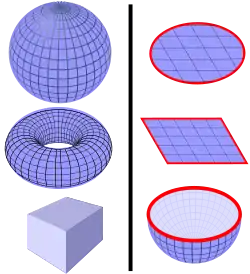Gauss's law for magnetism
In physics, Gauss's law for magnetism is one of the four Maxwell's equations that underlie classical electrodynamics. It states that the magnetic field B has divergence equal to zero,[1] in other words, that it is a solenoidal vector field. It is equivalent to the statement that magnetic monopoles do not exist.[2] Rather than "magnetic charges", the basic entity for magnetism is the magnetic dipole. (If monopoles were ever found, the law would have to be modified, as elaborated below.)
| Articles about |
| Electromagnetism |
|---|
 |
Gauss's law for magnetism can be written in two forms, a differential form and an integral form. These forms are equivalent due to the divergence theorem.
The name "Gauss's law for magnetism"[1] is not universally used. The law is also called "Absence of free magnetic poles";[2] one reference even explicitly says the law has "no name".[3] It is also referred to as the "transversality requirement"[4] because for plane waves it requires that the polarization be transverse to the direction of propagation.
Differential form
The differential form for Gauss's law for magnetism is:
where ∇ · denotes divergence, and B is the magnetic field.
Integral form

Left: Some examples of closed surfaces include the surface of a sphere, surface of a torus, and surface of a cube. The magnetic flux through any of these surfaces is zero.
Right: Some examples of non-closed surfaces include the disk surface, square surface, or hemisphere surface. They all have boundaries (red lines) and they do not fully enclose a 3D volume. The magnetic flux through these surfaces is not necessarily zero.
The integral form of Gauss's law for magnetism states:
![]()
where S is any closed surface (see image right), and dA is a vector, whose magnitude is the area of an infinitesimal piece of the surface S, and whose direction is the outward-pointing surface normal (see surface integral for more details).
The left-hand side of this equation is called the net flux of the magnetic field out of the surface, and Gauss's law for magnetism states that it is always zero.
The integral and differential forms of Gauss's law for magnetism are mathematically equivalent, due to the divergence theorem. That said, one or the other might be more convenient to use in a particular computation.
The law in this form states that for each volume element in space, there are exactly the same number of "magnetic field lines" entering and exiting the volume. No total "magnetic charge" can build up in any point in space. For example, the south pole of the magnet is exactly as strong as the north pole, and free-floating south poles without accompanying north poles (magnetic monopoles) are not allowed. In contrast, this is not true for other fields such as electric fields or gravitational fields, where total electric charge or mass can build up in a volume of space.
Vector potential
Due to the Helmholtz decomposition theorem, Gauss's law for magnetism is equivalent to the following statement:[5][6]
The vector field A is called the magnetic vector potential.
Note that there is more than one possible A which satisfies this equation for a given B field. In fact, there are infinitely many: any field of the form ∇ϕ can be added onto A to get an alternative choice for A, by the identity (see Vector calculus identities):
since the curl of a gradient is the zero vector field:
This arbitrariness in A is called gauge freedom.
Field lines
The magnetic field B, like any vector field, can be depicted via field lines (also called flux lines) – that is, a set of curves whose direction corresponds to the direction of B, and whose areal density is proportional to the magnitude of B. Gauss's law for magnetism is equivalent to the statement that the field lines have neither a beginning nor an end: Each one either forms a closed loop, winds around forever without ever quite joining back up to itself exactly, or extends to infinity.
Modification if magnetic monopoles exist
If magnetic monopoles were discovered, then Gauss's law for magnetism would state the divergence of B would be proportional to the magnetic charge density ρm, analogous to Gauss's law for electric field. For zero net magnetic charge density (ρm = 0), the original form of Gauss's magnetism law is the result.
The modified formula in SI units is not standard; in one variation, magnetic charge has units of webers, in another it has units of ampere-meters.
| Units | Equation |
|---|---|
| cgs units[7] | |
| SI units (weber convention)[8] | |
| SI units (ampere-meter convention)[9] | |
where μ0 is the vacuum permeability.
So far, no magnetic monopoles have been found, despite extensive search.[10]
History
This idea of the nonexistence of the magnetic monopoles originated in 1269 by Petrus Peregrinus de Maricourt. His work heavily influenced William Gilbert, whose 1600 work De Magnete spread the idea further. In the early 1800s Michael Faraday reintroduced this law, and it subsequently made its way into James Clerk Maxwell's electromagnetic field equations.
Numerical computation
In numerical computation, the numerical solution may not satisfy Gauss's law for magnetism due to the discretization errors of the numerical methods. However, in many cases, e.g., for magnetohydrodynamics, it is important to preserve Gauss's law for magnetism precisely (up to the machine precision). Violation of Gauss's law for magnetism on the discrete level will introduce a strong non-physical force. In view of energy conservation, violation of this condition leads to a non-conservative energy integral, and the error is proportional to the divergence of the magnetic field.[11]
There are various ways to preserve Gauss's law for magnetism in numerical methods, including the divergence-cleaning techniques,[12] the constrained transport method,[13] potential-based formulations[14] and de Rham complex based finite element methods[15][16] where stable and structure-preserving algorithms are constructed on unstructured meshes with finite element differential forms.
See also
References
- Chow, Tai L. (2006). Electromagnetic Theory: A modern perspective. Jones and Bartlett. p. 134. ISBN 0-7637-3827-1.
- Jackson, John David (1999). Classical Electrodynamics (3rd ed.). Wiley. p. 237. ISBN 0-471-30932-X.
- Griffiths, David J. (1998). Introduction to Electrodynamics (3rd ed.). Prentice Hall. p. 321. ISBN 0-13-805326-X.
- Joannopoulos, John D.; Johnson, Steve G.; Winn, Joshua N.; Meade, Robert D. (2008). Photonic Crystals: Molding the Flow of Light (2nd ed.). Princeton University Press. p. 9. ISBN 978-0-691-12456-8.
- Schilders, W. H. A.; et al. (2005). Handbook of Numerical Analysis. p. 13. ISBN 978-0-444-51375-5.
- Jackson, John David (1999). Classical Electrodynamics (3rd ed.). Wiley. p. 180. ISBN 0-471-30932-X.
- Moulin, F. (2001). "Magnetic monopoles and Lorentz force". Il Nuovo Cimento B. 116 (8): 869–877. arXiv:math-ph/0203043. Bibcode:2001NCimB.116..869M.
- Jackson, John David (1999). Classical Electrodynamics (3rd ed.). Wiley. p. 273, eq. 6.150.
- See for example equation 4 in Nowakowski, M.; Kelkar, N. G. (2005). "Faraday's law in the presence of magnetic monopoles". Europhysics Letters. 71 (3): 346. arXiv:physics/0508099. Bibcode:2005EL.....71..346N. doi:10.1209/epl/i2004-10545-2. S2CID 17729781.
- Magnetic Monopoles, report from Particle data group, updated August 2015 by D. Milstead and E.J. Weinberg. "To date there have been no confirmed observations of exotic particles possessing magnetic charge."
- Brackbill, J.U; Barnes, D.C (May 1980). "The Effect of Nonzero ∇ · B on the numerical solution of the magnetohydrodynamic equations". Journal of Computational Physics. 35 (3): 426–430. Bibcode:1980JCoPh..35..426B. doi:10.1016/0021-9991(80)90079-0.
- Tóth, Gábor (1 July 2000). "The ∇·B=0 Constraint in Shock-Capturing Magnetohydrodynamics Codes". Journal of Computational Physics. 161 (2): 605–652. Bibcode:2000JCoPh.161..605T. doi:10.1006/jcph.2000.6519. ISSN 0021-9991. S2CID 122112157.
- Hernquist, Lars; Vogelsberger, Mark; Mocz, Philip (21 July 2014). "A constrained transport scheme for MHD on unstructured static and moving meshes". Monthly Notices of the Royal Astronomical Society. 442 (1): 43–55. arXiv:1402.5963. Bibcode:2014MNRAS.442...43M. doi:10.1093/mnras/stu865. ISSN 0035-8711.
- Jardin, Stephen (2010). Computational Methods in Plasma Physics (1st ed.). Boca Raton: CRC Press. ISBN 9780429075537.
- Hu, Kaibo; Ma, Yicong; Xu, Jinchao (1 February 2017). "Stable finite element methods preserving ∇·B=0 exactly for MHD models". Numerische Mathematik. 135 (2): 371–396. doi:10.1007/s00211-016-0803-4. ISSN 0945-3245. S2CID 30546761.
- Ma, Yicong; Hu, Kaibo; Hu, Xiaozhe; Xu, Jinchao (July 2016). "Robust preconditioners for incompressible MHD models". Journal of Computational Physics. 316: 721–746. arXiv:1503.02553. Bibcode:2016JCoPh.316..721M. doi:10.1016/j.jcp.2016.04.019. S2CID 7777728.
External links
 Media related to Gauss's law for magnetism at Wikimedia Commons
Media related to Gauss's law for magnetism at Wikimedia Commons